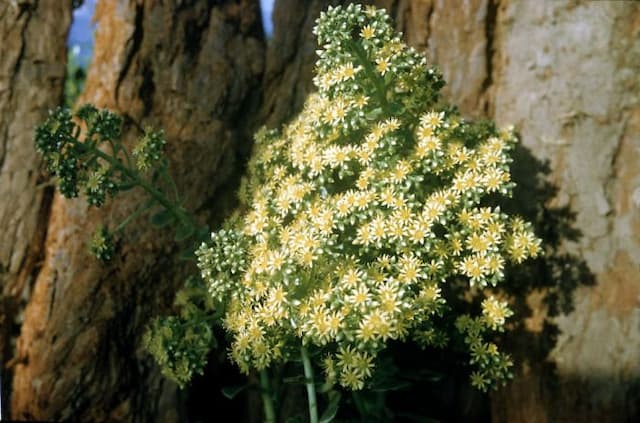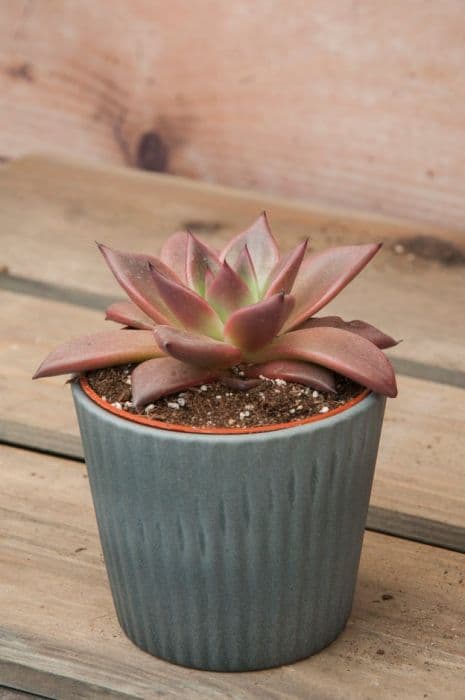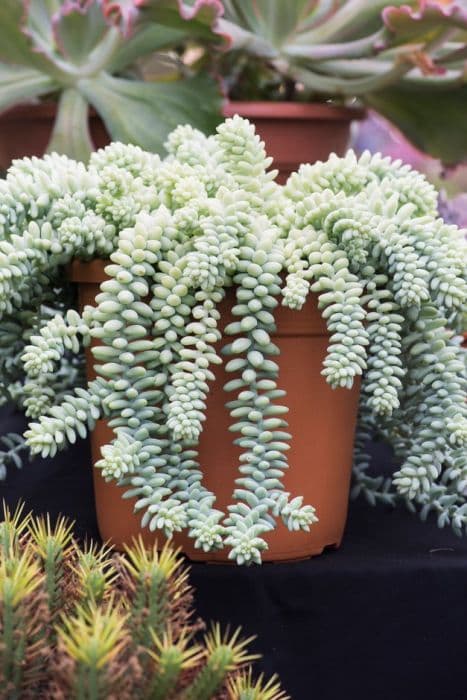Britton's Dudleya Dudleya brittonii

ABOUT
The Dudleya brittonii, commonly known as the Giant Chalk Dudleya or Britton's Dudleya, is a succulent plant with a visually striking appearance. This plant bears a rosette formation made up of thick, fleshy, spoon-shaped leaves. These leaves have a distinctive powdery-white or silver-gray coating, which comes from a natural waxy substance that helps the plant retain water. The smooth texture and coloration of its foliage give it the chalky appearance that inspires its common name. The leaves are broad at the base, tapering to a point at the tip. They often curl slightly back towards the center of the rosette, forming an elegant and tightly packed spiral. This dense arrangement contributes to its sculptural quality. During its flowering season, the Giant Chalk Dudleya sends up a long stalk from the center of the rosette. Atop this stalk, bright yellow or red flowers bloom, creating a striking contrast against the pale leaves. The blossoms are star-shaped and grouped together at the end of the stalk, adding a burst of color to its overall aesthetic. The flowering stalk is often much taller than the foliage, adding vertical interest to the plant's structure. Overall, the Giant Chalk Dudleya has a sturdy and enduring look, yet maintains a soft and almost otherworldly beauty due to its unique color and form. It is a popular choice for rock gardens, succulent collections, and as a feature in drought-tolerant landscaping due to its appealing and resilient nature.
About this plant
 Names
NamesFamily
Crassulaceae
Synonyms
Giant Chalk Dudleya, Britton's Dudleya, White Liveforever
Common names
Dudleya brittonii
 Toxicity
ToxicityTo humans
The plant commonly known as the Giant Chalk Dudleya (Dudleya brittonii) is not known to be toxic to humans. However, as with any non-food plants, ingesting parts of this plant is not advisable and could potentially cause stomach upset or discomfort due to compounds that may be irritating to the digestive tract.
To pets
The Giant Chalk Dudleya is also not known to be toxic to pets. Nonetheless, it is typically recommended to prevent pets from ingesting plants that are not part of their diet. If a pet were to ingest this plant, it might experience mild gastrointestinal upset, including symptoms like vomiting or diarrhea. However, these are general symptoms and may not specifically apply to the ingestion of Giant Chalk Dudleya. It's always best to consult with a veterinarian if you suspect your pet has ingested any plant material that may be concerning.
 Characteristics
CharacteristicsLife cycle
Perennials
Foliage type
Evergreen
Color of leaves
Silver
Flower color
Yellow
Height
1 foot (0.3 meters)
Spread
1 foot (0.3 meters)
Plant type
Succulent
Hardiness zones
9
Native area
Mexico
Benefits
 General Benefits
General Benefits- Ornamental appeal: Dudleya brittonii, commonly known as Giant Chalk Dudleya, has a unique rosette form and silvery-white leaves that add aesthetic value to gardens and landscapes.
- Drought resistance: As a succulent, it is extremely drought-tolerant, making it ideal for water-wise gardens and xeriscaping in arid environments.
- Low maintenance: This plant requires minimal care once established, making it a good choice for busy plant enthusiasts or those new to gardening.
- Attracts pollinators: When in bloom, Giant Chalk Dudleya attracts bees, butterflies, and other pollinators that are beneficial to the garden ecosystem.
- Soil erosion control: Its root system helps to stabilize soil in sloped gardens and prevent erosion.
- Versatility in landscaping: Suitable for rock gardens, container gardening, and coastal settings, providing flexibility in landscape design.
- Longevity: As a perennial, Dudleya brittonii can live for many years, offering long-term value for a garden or planting arrangement.
 Medical Properties
Medical PropertiesThis plant is not used for medical purposes.
 Air-purifying Qualities
Air-purifying QualitiesThis plant is not specifically known for air purifying qualities.
 Other Uses
Other Uses- Dudleya brittonii, commonly known as 'Giant Chalk Dudleya,' can be used as a source of subtle color for watercolor painting when its powdery coating is mixed with binding agents.
- Since Giant Chalk Dudleya retains water in its leaves, it can be utilized in survival situations as an emergency water source by squeezing the moisture from the leaves.
- The rosettes of Giant Chalk Dudleya can be used in traditional corsages and boutonnieres as a sustainable alternative to cut flowers for special events.
- This succulent's striking appearance allows it to be a living sculpture in minimalist and modern art installations, augmenting the visuals with its geometrical leaf pattern.
- In photography, Giant Chalk Dudleya serves as a unique subject for botanical macro photography, highlighting its powdery surface and architectural form.
- Giant Chalk Dudleya can also be used in green roofs, where its drought resistance and low maintenance make it an excellent choice for sustainable building practices.
- Its slow-growing and clumping nature allows for use as a natural barrier or living fence in xeriscaping and drought-tolerant landscapes.
- The plant can be integrated into educational programs about drought-resistant gardening and California native species for conservation efforts.
- Giant Chalk Dudleya can be used as a natural way to reduce erosion on slopes due to its extensive root system and ground-holding capabilities.
- During seasonal festivities, the plant can act as a sustainable and live alternative to more traditional decorations such as wreaths or Christmas ornaments.
Interesting Facts
 Feng Shui
Feng ShuiThe Giant Chalk Dudleya is not used in Feng Shui practice.
 Zodiac Sign Compitability
Zodiac Sign CompitabilityThe Giant Chalk Dudleya is not used in astrology practice.
 Plant Symbolism
Plant Symbolism- Resilience: Dudleya brittonii, commonly known as Giant Chalk Dudleya, is known for its ability to survive in arid conditions, symbolizing the ability to endure and thrive in challenging environments.
- Longevity: With its slow growth and potential to live for decades, Giant Chalk Dudleya represents a long life and persistence over time.
- Uniqueness: The distinct rosette pattern and chalky appearance of the Giant Chalk Dudleya embody individuality and the beauty in being unique.
- Self-Sufficiency: Due to its low water needs and the fact that it thrives in poor soil, this plant symbolizes independence and the ability to care for oneself without needing outside help.
 Water
WaterGiant chalk dudleya prefers infrequent but thorough watering. During the active growing season in spring and fall, water every 2-3 weeks with about 0.5 gallons per plant, ensuring the water penetrates the soil deeply. In the summer, water sparingly, only when the soil is completely dry. Reduce watering to once a month or even less in winter, as overwatering during dormancy can lead to root rot. Always allow the soil to dry out between watering sessions.
 Light
LightGiant chalk dudleya thrives in bright light with some direct sun. It is best placed in a spot where it can receive at least 6 hours of sunlight daily. An ideal location would be a south-facing or west-facing window where the sunlight is plentiful but not too harsh. Avoid deep shade, as this can lead to etiolation and poor health of the plant.
 Temperature
TemperatureGiant chalk dudleya prefers moderate to warm temperatures, ideally between 65-75°F, but can withstand temperatures down to 40°F and up to 90°F. Ensure the plant is protected from frost, which can be damaging. The ideal growing conditions are in coastal areas where temperatures are consistently mild throughout the year.
 Pruning
PruningPruning of giant chalk dudleya is generally done to remove dead or damaged leaves and to maintain plant shape. Prune sparingly, only when necessary, and the best time is in the late fall or early winter at the end of the growing season. Use clean and sharp tools to make precise cuts, which will help prevent potential infections.
 Cleaning
CleaningAs needed
 Soil
SoilGiant chalk dudleya thrives in a fast-draining cactus or succulent mix with added sand or pumice for extra drainage. A soil pH range of 6.0 to 7.5 is ideal for this plant.
 Repotting
RepottingGiant chalk dudleya does not need frequent repotting and can be repotted every 2-3 years to replenish the soil, or when the plant has outgrown its pot.
 Humidity & Misting
Humidity & MistingGiant chalk dudleya prefers low humidity conditions, typical of arid or semi-arid environments, as it is a drought-tolerant species.
 Suitable locations
Suitable locationsIndoor
Ensure bright light, minimal water.
Outdoor
Plant in well-draining soil, full sun.
Hardiness zone
9-11 USDA
 Life cycle
Life cycleGiant chalk Dudleya (Dudleya brittonii) begins its life as a seed, often dispersed in the environment by wind or water. After germination, the seedling develops a small rosette of fleshy leaves capable of storing water, adapting it to its arid native habitats. As the plant matures, its rosette grows larger, and it can produce offsets, or small clones, which contribute to asexual reproduction. During its flowering stage, usually in the spring, Dudleya brittonii sends up tall flower stalks with clusters of yellow or red flowers that attract pollinators for sexual reproduction. After pollination, seeds are produced and dispersed, completing the reproductive cycle. This succulent can live for several decades, with individual leaves lasting several years before being shed and replaced by new growth from the center of the rosette.
 Propogation
PropogationPropogation time
Spring to Summer
Propogation: Dudleya brittonii, commonly known as the Giant Chalk Dudleya or Britton's Dudleya, is best propagated through leaf cuttings, a process that is most successful when performed in late spring or early summer which coincides with their active growth period. To propagate, a healthy leaf is gently twisted off the plant, ensuring that it comes away with a clean break. The leaf is then allowed to callous over for a few days in a warm, dry location to prevent rotting when planted. Once calloused, it's placed on top of a well-draining cactus or succulent potting mix, barely pressing it into the surface. Mist the soil lightly to provide moisture without causing the leaf to rot (approximately 2 tablespoons or 30 milliliters). Roots and a new rosette will typically form at the base of the leaf within several weeks, requiring indirect light and minimal water until fully established.









